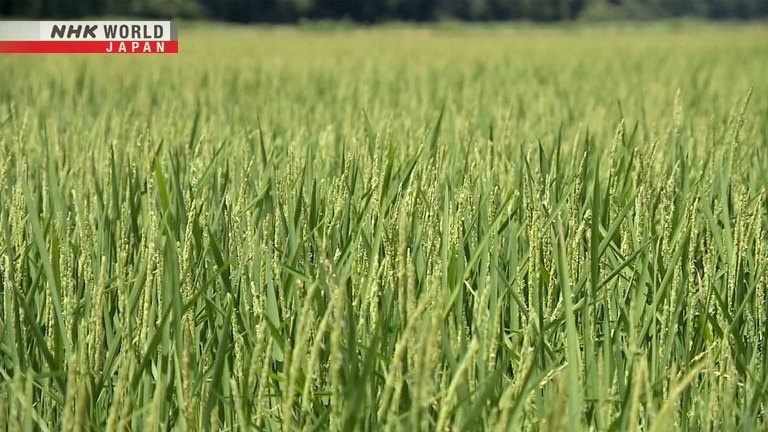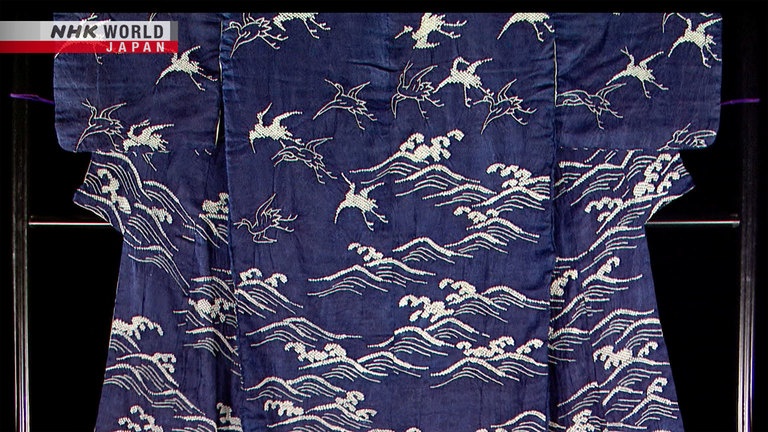Blue
The Japanese language is rich in words and expressions influenced by nature, history and culture. This episode introduces words related to the color blue. Its many shades were used skillfully by Japanese ukiyo-e artists who significantly influenced famous painters worldwide. The Japanese word for blue covers a wide range of colors and has produced an equal variety of expressions. From his home in Kyoto Prefecture, poet and literary translator Peter MacMillan guides us through these words and the culture behind them.




Transcript
"Yukigesho."
"Karakurenai."
The Japanese language is rich in unique expressions that reflect nature and culture.
Magical Japanese.
Today's theme is "ao," or blue.
Japan is surrounded by oceans, and its mountains are flowing with waterfalls and rivers.
So, Japanese people have a natural affinity for the color blue in its many forms.
In fact, it's a color often used to represent Japan.
Hello, I'm Peter MacMillan.
When I think of the color blue in Japan, ukiyo-e come to mind.
Japanese artists, like Katsushika Hokusai, influenced painters around the world,
and they used blue in many of their works, skillfully distinguishing between different shades of the color.
Indeed, one commonly speaks of "Hokusai Blue."
Today we will look at some expressions related to the color blue.
"aotenjo."
"Tenjo" means ceiling, and "aotenjo" refers to a blue sky.
The expression likens the sky to a ceiling with no limit.
It's often used when talking about market prices and financial topics.
For example:
What's the pay at your company?
That depends entirely on performance.
For anyone who produces results, it's "aotenjo"—limitless.
"aotenjo."
In English, when prices rise suddenly and dramatically,
you can compare them to firework rockets called "skyrockets," and say that "prices are skyrocketing."
It's interesting how similar the expressions are.
The range of colors covered by the Japanese word "ao" is quite broad, covering everything from purple to green.
For example, although this bamboo, or "take," is green, it's called "aodake," literally "blue bamboo."
There are also other expressions that use "ao" to refer to things that are in fact green.
"aotagai."
"Ta" means rice paddy, and "gai" comes from "kai," or to buy.
Rice paddies are planted in spring and become fields of green in summer, or "aota."
"Aotagai" is to purchase a future harvest, while the plants are still green.
Today, the expression refers to the practice of recruiting new hires before they've finished school.
I just entered university, but I'm already getting internship invitations.
There's a labor shortage, so everyone is desperate to "aotagai"—recruit in advance.
"aotagai."
"seishun."
"Sei" is another way to say "blue," and "shun" means spring.
The word "seishun," originally from China, compares youth to "the springtime of life."
I'm really looking forward to university life!
Be sure to enjoy your "seishun"—youth—to the full.
"seishun."
Incidentally, the character for "shun" can also be read as "haru."
Young people these days like to intentionally change the readings, so it seems they also refer to "seishun" as "aoharu."
You might hear a conversation like this:
Hey, my friend and I are going to bring our partners along, and have a double date.
Wow, that's so "aoharu!"
Moving on, there are many different ways to refer to the color blue in Japanese.
"gunjo-iro."
This pigment, made from a natural mineral, has a vibrant, deep-blue hue, similar to ultramarine.
"kon-iro."
"Kon-iro" is a dark blue with a purple tone.
Since ancient times, the Japanese have used a pigment derived from "ai," or the Japanese indigo plant, to dye their clothes.
You can say that the blue color of this indigo dye is the representative blue of Japan.
In the late 19th century, the British chemist Robert William Atkinson came to Japan,
and was surprised to see Japanese people wearing indigo clothes wherever he went.
He named the color "Japan Blue."
Indigo also features in the following expression.
"ao wa ai yori idete ai yori aoshi."
This loosely translates as "the blue produced from the indigo plant is bluer than the indigo plant itself."
It's similar to the English expression, "the student has become the master."
I taught my grandson chess, but I probably couldn't beat him now.
"Ao wa ai yori idete ai yori aoshi."
The student has become the master.
"ao wa ai yori idete ai yori aoshi."
Although laws were passed in the Edo period forbidding clothes made with luxurious materials and colors,
blue kimono dyed with indigo were not restricted.
Indigo dyeing became very popular because it was believed to be effective in warding off insects and preventing odors.
The indigo-dyeing shops were called "konya" or "kouya,"
and they were very prosperous, giving rise to the following expression.
"konya no shirobakama."
"Shirobakama" is a white work outfit.
The story goes that an indigo dyer was so busy dyeing other people's clothes, that his own remained white.
The resulting expression describes someone who is so busy working for others, that they can't do things for themselves.
I hear he became the editor of a food magazine.
But he's so busy he never gets to eat out.
You know what they say, "konya no shirobakama"—the indigo dyer's garment stays white.
"konya no shirobakama."
"aoiki toiki."
"Iki" means a breath, and "toiki" is a sigh.
"Aoiki toiki" means to let out a blue or dejected sigh, when one is in distress or at their wits' end.
The price of everything is rising, and it seems the electric bill will be going up too.
But my salary stays the same.
I'm "aoiki toiki"—at my wits' end.
"aoiki toiki."
In Japan they say that "happiness escapes whenever you sigh."
Speaking of escaping, if you ever notice that someone's temples have turned blue, it might be best to run away immediately.
"aosuji o tateru."
Here, "suji" refers to veins.
"Aosuji o tateru" refers to how bluish veins bulge, when someone is agitated or furious.
Hey! That's not fair!
Calm down. It's nothing to "aosuji wo tateru"—be furious about.
"aosuji o tateru."
It's no fun constantly getting yelled at by someone who's making their blue veins pop out.
It makes me "exhale a blue sigh." Oooh...
Ah... that was close!
My happiness almost escaped!
See you next time.
Bye.